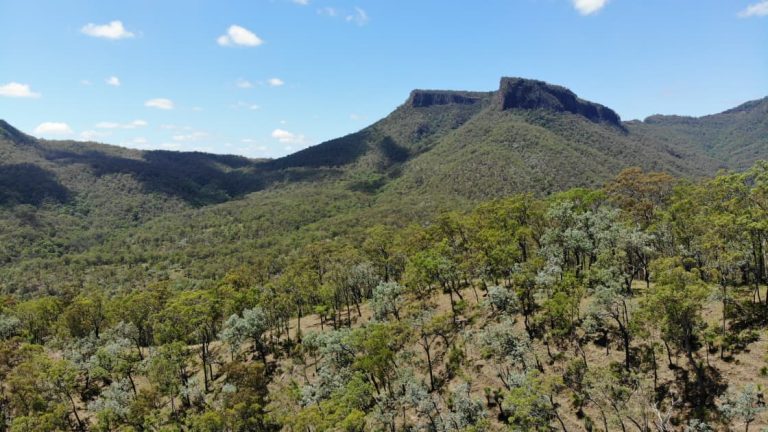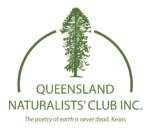
Excursion Report – Mount Castle Valleys, Laidley, QLD, held 4- 6 May 2024, Leader: David Bouchard
4- 6 May 2024, Mount Castle Valleys, Laidley Leader and Report: David Bouchard
The Mount Castle Valleys excursion was held on the Crosby property, at the head of Laidley Creek about 40 min drive south from Laidley. The owner Glynn Crosby and his daughter Laura have opened up their very scenic cattle property for campers. Their farm borders the northern end of the Main Range National Park with the dramatic Mt Castle at the southern end of property, the Little Liverpool Range forming the eastern boundary, and the rainforest clad Mistake Range to the west.
Geologically the area is part of the Main Range volcano, which erupted lava around 26M years ago. Most of the lava flows consisted of basalt, a dark rock rich in iron and magnesium originating from the earth’s mantle. However the cliff lines of Mt Castle consist of trachyte, a lighter coloured and more erosion resistant lava, richer in silica and potassium feldspar.
Being a long weekend and so close to Brisbane, the camp was well attended with 18 Nats camping, and seven coming along for day trips. Our group had five children who had a great time exploring, nature study, swimming in the creek and of course enjoying the campfire at night.
While setting up camp on Saturday we heard noisy miners complaining about something on the other side of the creek. A quick investigation revealed the source of their ire was a barking owl. Not only did this poor bird have its sleep disturbed by miners, it then had to put up with the paparazzi with their long lenses!
There were a few light showers that afternoon, but this did not stop us ambling up the creek naturalising for about a kilometre. Crimson rosellas were very common, feeding on the seed heads of weeds beside the creek. That evening we went spotlighting in the eucalypt forest near the camp. Glynn had lent us an infrared night vision scope that would pick up any warm blooded animals. This proved to be very useful, as we were able to locate a squirrel glider, the highlight for the night.
The next day dawned fine and clear, so Glynn suggested we go up the old forestry road on the ridge that leads up onto the Mistake Range. About half of the party hiked up the road while the rest were ferried up by four wheel drives. The grass tree Xanthorrhoea glauca with its multi heads was very common on the ridge. This area had been severely burnt by the fires that swept along the Main Range at the end of 2019. A grove of piccabeen palms Archontophoenix cunninghamiana growing in a soak had somehow survived the fire, reshooting after shedding their burnt fronds. They now looked rather exposed. I was uncertain whether they were always been that way, or had lost their canopy trees in the fires.
The upper third of the road was within the National Park and we were able to get within 400m of the “winder track” along the crest of the range, when we were blocked by a wall of lantana and raspberry. It was here the open forest started to merge with the rainforest, with black booyong Argyrodendron actinophyllum being a dominant tree. The steep terrain here also favoured the giant spear lily Doryanthes palmeri which covered the cliffs above us. Bright green liverworts and a red triangle slug Triboniophorus graeffei were observed on the damp rocks beside the road. This slug is closely related to the pink slug we saw at Mt Kaputar last year.
We had lunch on a corner of the road at the old forestry shute, where logs were once slid down from the top of the range to the road. From here we could look east over top of the Little Liverpool Range and see Brisbane on the horizon.
That night we went to a different area of forest spotlighting, but only found brushtail possums and sleeping birds. The weekend coincided with a moonless sky and the Eta Aquarid meteor shower, so conditions would have been ideal for viewing them. Unfortunately cloud hindered us seeing anything on Sunday morning, but Penny got up before dawn on Monday, and witnessed around 10 meteors over half an hour. Not exactly a “shower” but certainly more than you would normally see.
On Monday five day trippers joined us and we then drove further up the valley to near the base of Mt Castle. Some of us hiked up to the picturesque water hole, where the kids and other brave souls enjoyed a cool dip, while the rest of the party spent time around a farm dam photographing insects and birds. Glynn then took a group of us along an old logging road on lantana infested slopes to see more native plants including the velvet leaf bush. This was aptly named Callicarpa, which means beautiful fruit. The tiny purple fruit in umbels were somewhat reminiscent of lantana “berries”.
Many thanks to Glynn and Laura for taking time off from farm work to show us around their property. Both of them have an interest in natural history and have set up an iNaturalist project for their property at Mt Castle Valleys · iNaturalist Australia (ala.org.au), where they have currently recorded 1170 species. Greg Neill also set up a project for our visit at QNC 2024 May – Mt Castle Valleys · iNaturalist Australia (ala.org.au), where 271 species were recorded. Be sure to take a look as there are some excellent photos by members.
Greg also logged 53 bird species seen by the Nats, this list can be viewed at https://ebird.org/tripreport/236148
If you would like to visit the property privately, you can book through the “Hipcamp” website under Mt Castle Valleys. Day trippers are welcome but overnight campers need to bring their own toilet.
